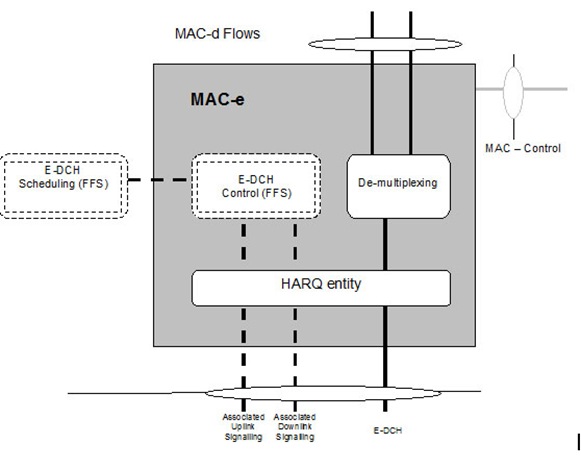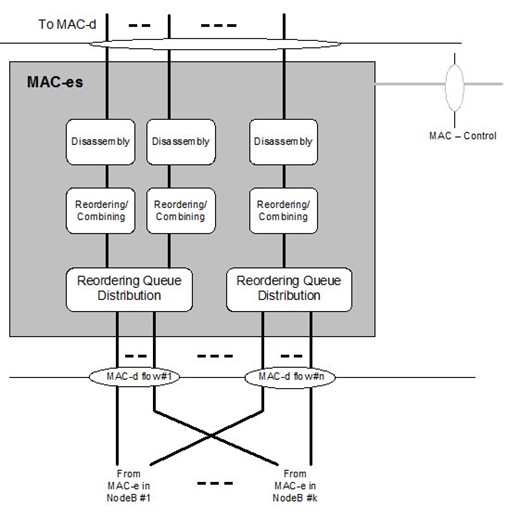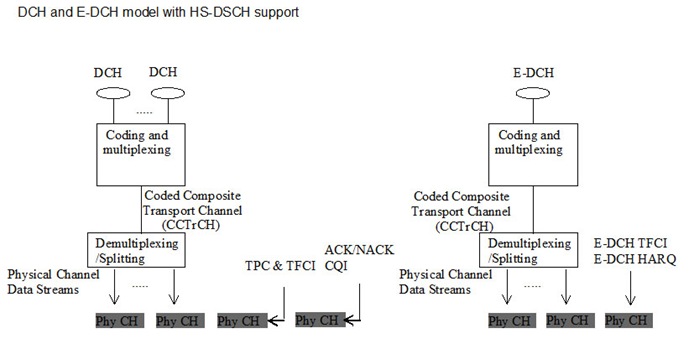High Speed Uplink Packet Access (HSUPA) is introduced in 3GPP Release 6 standards to improve the uplink UE data rate which was significantly low up to Release 5. To improve the uplink data rate some new functionality are added:
- New MAC entities: MAC-e/es in UE and MAC-e in NodeB and MAC-es in RNC.
- Transport channel: E-DCH
- Physical channels: E-DPDCH/DPCCH, E-HICH, E-RGCH, E-AGCH
- Transmission Time Interval: 2 ms or 10 ms
- SF = 2 can be used
- Fast Layer 1 transmission and retransmission
- Hybrid- ARQ using soft combining and incremental redundancies
- NodeB control grants or data rate
- New Frame Protocol in Iub/Iur interface (E-DCH FP)
MAC Protocol
HSUPA introduced some changes in MAC protocol both in the UE and network side.
- MAC-e in the NodeB
- MAC-es in the SRNC
- MAC-e/es in the UE
MAC –e in the NodeB
The MAC-e entity is located in the NodeB. There is one MAC-e entity in the NodeB for each UE.
The MAC-e entity is responsible for
- Managing the cell resources related to HSUPA between UEs.
- Receiving the scheduling requests from the UEs and transmission of scheduling grants.
- De-multiplexing of MAC-e PDUs into MAC-es PDUs.
- Management of HARQ entity, which is responsible for transmitting ACK/NACK.
MAC-es in SRNC
For each UE there is one MAC-es entity in the SRNC. The MAC-es covers the following functionalities:
- Combining and reordering the MAC-es PDUs according to TSN and NodeB tagging i.e. (CFN and subframe number)
- Disassembling the MAC-es PDUs. When MAC-es PDUs are disassembled the MAC-es header is removed and MAC-d PDUs are extracted. Then the MAC-d PDUs are delivered to MAC-d entity.
MAC-e/es in UE
MAC-e/es handles the E-DCH specific functions in the UE. There are three different entities in MAC-e/es.
HARQ
HARQ entity is responsible for ACK/NACK handling. It receives ACK/NACK from the nodeB and act accordingly.
Multiplexing and TSN setting
Multiplexing and TSN setting entity is responsible for concatenating multiple MAC-d PDUs into one MAC-es PDU, and to multiplex several MAC-es PDUs into one MAC-e PDU.’
E-TFC selection
This entity is responsible for E-TFC selection taking the following into consideration:
- Relative Grant
- Absolute Grant
- Serving Grant
E-DCH Transport Channel
On the uplink when E-DCH is supported, two CCTrCH are used simultaneously. The E-DCH transport channel can be configured with 10 ms TTI or with 2 ms TTI. 10 ms TTI is mandatory and must be supported by all UEs which support E-DCH, but 2 ms TTI is optional.
UE can have only one E-DCH transport channel at a given point of time. The E-DCH can be mapped onto one CCTrCH of E-DCH type at a given point of time and there will be only one Transport Block (TB) per TTI.
Physical Channels for HSUPA
Enhanced Dedicated Physical Data Channel (E-DPDCH)
The E-DCH transport blocks are carried on the E-DPDCH channel in the physical layer. E-DPDCH operates in 2 ms or 10 ms TTI. Release 6 E-DPDCH uses QPSK modulation and in Release 7 there is possibility to use 4 PAM modulations.
The E-DPDCH does not carry any other information other than data symbols. It depends on the DPCCH to carry pilot symbols and channel estimation and on E-DPCCH to carry E-TFC, Retransmission Sequence Number (RSN) and happy bit.
E-DPDCH uses multi-codes combinations to increase the data rate. Spreading Factor 2 (SF 2) can also be used.
So the different possibilities of data rates with code combinations:
|
Number of codes |
Data Rate (kbps) |
|
One code with SF 4 |
960 |
|
Two codes with SF 4 |
1920 |
|
Two codes with SF 2 |
3840 |
|
Two codes with SF 4 and two codes with SF 4 |
5760 |
Release-6 E-DPDCH
Release-7 E-DPDCH
Enhanced Dedicated Physical Control Channel (E-DPCCH)
E-DPCCH carries HSUPA-related physical layer control information. E-DPCCH always follows the TTI length of E-DPDCH.
The E-DPCCH carries the following information:
- E-TFC information which is 7 bits long. E-TFC determines the data rate.
- 2 bits of retransmission information. RSN tells whether the packet is a new or retransmission of a previously transmitted packet.
- The last 1 bit is the happy bit which tells whether the UE can use a higher uplink data rate or not.
For 2 ms TTI Case
- The 10 information bits are coded into 30 bits over three consecutive time slots.
For 10 ms TTI Case
- The content of 2 ms subframes are simply repeated five times.
E-DCH Hybrid ARQ Indicator Channel (E-HICH)
E-HICH channel is used to send the ACK/NACK information in the downlink i.e. NodeB indicates whether a packet is correctly received from a UE or not.
E-HICH is shared by multiple users at the same time. Each user is allocated one orthogonal signature for E-HICH and one for E-RGCH. Since there are 40 orthogonal signatures are available so only 20 users can use the same code channel at a specific point of time.
E-DCH Relative Grant Channel (E-RGCH)
E-RGCH is used to step up or step down the output power used by the UE. So E-RGCH does not carry any exact value but an indication to go up or down relative to the current serving grant.
E-HICH uses the same code channel as E-HICH to save code space.
E-DCH Absolute Grant Channel (E-AGCH)
An E-DCH Absolute Grant Channel is transmitted by the serving E-DCH cell. It carries two kind of information:
- AG value
- AG scope
AG value is the exact E-DPDCH/DPCCH power ratio that the UE need to use in the next transmission.
AG scope tells whether the AG value will be used by a single HARQ process or will be used by all processes.
UE Capabilities
When establishing RRC connection UE sends it E-DCH capabilities to the NW. In the RRC CONNECTION SETUP COMPLETE, UE sends information about E-DCH Physical layer category.
Release 6
|
E-DCH category |
Maximum number of E-DCH codes transmitted
|
Minimum spreading factor
|
Support for 10 and 2 ms TTI EDCH |
Maximum number of bits of an E-DCH transport block transmitted within a 10 ms E-DCH TTI |
Maximum number of bits of an E-DCH transport block transmitted within a 2 ms E-DCH TTI |
|
Category 1 |
1 |
SF4 |
10 ms TTI only |
7110 |
– |
|
Category 2 |
2 |
SF4 |
10 ms and |
14484 |
2798 |
|
Category 3 |
2 |
SF4 |
10 ms TTI only |
14484 |
– |
|
Category 4 |
2 |
SF2 |
10 ms and |
20000 |
5772 |
|
Category 5 |
2 |
SF2 |
10 ms TTI only |
20000 |
– |
|
Category 6 |
4 |
SF2 |
10 ms and |
20000 |
11484 |
|
NOTE: When 4 codes are transmitted in parallel, two codes shall be transmitted with SF2 and two with SF4 |
|||||
Release 7
|
E-DCH category |
Maximum number of E-DCH codes transmitted
|
Minimum spreading factor
|
Support for 10 and 2 ms TTI EDCH |
Maximum number of bits of an E-DCH transport block transmitted within a 10 ms E-DCH TTI |
Maximum number of bits of an E-DCH transport block transmitted within a 2 ms E-DCH TTI |
|
Category 1 |
1 |
SF4 |
10 ms TTI only |
7110 |
– |
|
Category 2 |
2 |
SF4 |
10 ms and |
14484 |
2798 |
|
Category 3 |
2 |
SF4 |
10 ms TTI only |
14484 |
– |
|
Category 4 |
2 |
SF2 |
10 ms and |
20000 |
5772 |
|
Category 5 |
2 |
SF2 |
10 ms TTI only |
20000 |
– |
|
Category 6 |
4 |
SF2 |
10 ms and |
20000 |
11484 |
|
Category 7 |
4 |
SF2 |
10ms and 2 ms TTI |
20000 |
22996 |
|
NOTE: When 4 codes are transmitted in parallel, two codes shall be transmitted with SF2 and two with SF4 |
|||||
References
Enhanced uplink; Overall description: 3GPP TS 25.319
UE Radio Access capabilities: 3GPP TS 25.306
FDD Enhanced Uplink;Overall description;Stage 2: 3GPP TS 25.309
Medium Access Control (MAC) protocol specification: 3GPP TS 25.321






![clip_image001[6] clip_image001[6]](http://www.3glteinfo.com/wp-content/uploads/2009/10/clip_image0016_thumb.jpg)
![clip_image001[8] clip_image001[8]](http://www.3glteinfo.com/wp-content/uploads/2009/10/clip_image0018_thumb.jpg)
Permalink
Terrific work! This is the type of information that should be shared around the web. Shame on the search engines for not positioning this post higher!
Permalink
Wow this is a great resource.. I’m enjoying it.. good article
Permalink
Thanks Prashant, great work !!!!
Permalink
Thanks Jay
Permalink
How to set +1,-1 or 0 in E-HICH? I can’t understand the sequence in the slot.
Permalink
Hi Mahui,
I will look into your question and let you know. In the mean time you can check spec.
Permalink
I have just looked at the table provided in the E-DPDCH section….It says that Rel. 6 uses QPSK then it should be 1920 Kbps with one code SF4 but it is 960 Kbps.
If BPSK is used with one SF4 then the bit rate is 960Kbps. If QPSK is used then how this could be 960Kbps with one SF4?